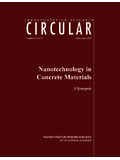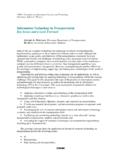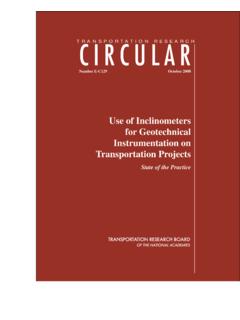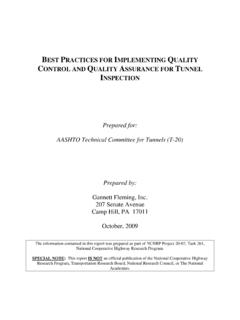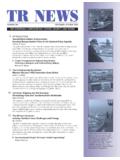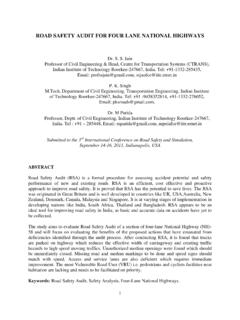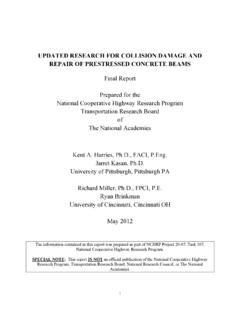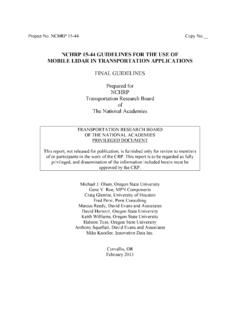Transcription of Types of Piles: Their Characteristics and General Use
1 Types of Piles: Their Characteristics and General Use BERNARD A. GRAND, Hardesty and Hanover This paper presents a review of the current practice and usage of the numerous Types of pile in General construction. Information on this sub- ject was obtained from a review of existing literature and from field ex- perience. The paper reviews the purpose of pile foundations and the various factors involved in the selection of a type of Emphasis is placed on the General , physical, and structural Characteristics of the piles as well as durability and fabrication. Data are presented on the inherent advantages and disadvantages of the various Types of piles and on corre- sponding optimum pile length and load range.
2 Information and data are presented on the field problems of pile installations and the proper meth- od of handling and treabnent to avoid damage or failure of critical pile sections. The fundamental information is supplemented by case histories. PILE FOUNDATIONS of timber were in use in ancient times. In its earliest form, a pile foundation consisted of rows of timber stakes driven into the ground. Pile founda- tions such as these were used by the ancient Aztecs in North America. The Romans made frequent use of pile foundations as recorded by Vitruvius in 59 AD. Pile founda- tions for ancient Roman dwellings have been found in Lake Lucerne.
3 It is reported that during the rule of Julius Caesar a pile-supported bridge was constructed across the Rhine River. The durability of timber piles is illustrated ill the report of the reconstruction of an ancient bridge in Venice in 1902. The submerged timber piles of this bridge, which were driven in 900 AD, were found in good condition and were reused. In the years immediately preceding the turn of the twentieth century, several Types of concrete piles were devised. These early concrete piles were the cast-in-place type. Further development of the concrete pile led to the precast pile and, relatively recently, to the prestressed concrete pile.
4 The need for extremely long piles with high bearing capacity led to the use of concrete-filled steel-pipe piles about 50 to 60. years ago. More recently, steel H-piles have come into common usage. Their ease of handling, fabrication, splicing, and relatively easy penetration hastened Their ac- ceptability in foundation construction. THE PURPOSE OF A PILE FOUNDATION. r The primary function of a pile foundation is (a) to transmit the load of a structure through a material or stratum of poor bearing capacity to one of adequate bearing ca- pacity; (b) in some instances, to improve the load-bearing capacity of the soil; and (c) to resist lateral loads and to function as a fender to absorb wear and sbcick.
5 In ad- dition, piles are also used in special situations (a) to eliminate objectionable settle- ment; (b) to transfer loads from a structure through easily er0ded soils in a scour zone to a stable underlying bearing stratum; (c) to anchor structures subjected to hy- drostatic uplift or overturning; and (d) to serve as a retaining structure when hlstalled in groups or in a series of overlapping (cast-in-place) piles. Paper sponsored by Committee on Substructures, Retaining Walls and Foundations and presented at the 49th Annual Meeting. 3. 4. NEED FOR SUBSURFACE INVESTIGATIONS. The length of the pile and the method of pile installation are dependent on the nature of the subsurface conditions.
6 Thorough subsurface explorations are necessary to de- termine the stratification of the foundation elements, including the depth to bedrock and the density of granular materials measured by the number of blows recorded on a standard split spoon sampler, and to obtain undisturbed samples of cohesive strata to evaluate the shearing strength and compressibility Characteristics by laboratory test- ing. The desirable number of exploratory borings depends on the size of the founda- tion area and the degree of uniformity of the foundation materials. In areas of glacial deposits, the foundation materials tend to be nonuniform, whereas the soil conditions are generally more uniform in marine or alluvial deposits.
7 Ideally, subsurface explorations should extend to a depth of 100 ft or to a depth of 1~ times the width of the sb. ucture, unless bedrock is encountered at a shallower depth. Gi oundwater conditions are pertinent in a pile foundation project from the stand- point of the probable permanency of the groundwater level, which is relevant to pre- serving the permanency of untreated timber piles. The condition of the groundwater is also relevant to steel and concrete piles where acid, alkali, or other injurious solu- tions may be present. CHOICE OF PILE TYPE. The initial and primary consideration is the evaluation of the foundation materials and the selection of the substratum that will provide the best pile foundation support.
8 In certain situatioDB involving cohesive subsoils, the pile lengths will be dictated by the necessity to minimize settlement of the foundations rather than the need to develop load capacity. The selection of o. type of pile for a given foundation should be made on the basis of a comparative study of cost, permanency, stability under vertical and a horizontal loading, long-term settlement, if any, of the foundation, required method of pile installation, and length of pile required to develop sufficient point bearing and frictional resistance assuming that there is a great depth to bedrock or other hard bottom.
9 The selection of a pile type and its appurtenances is dependent on environmental factors as, for example, piles in seawater. Environmental factors to be considered are the possibility of marine borer attack, wave action causing alternate wetting and dry- ing and ultimate deterioration, and abrasion due to moving debris or ice. Piles lo- cated in strong water currents could be subject to gradual erosion of the pile material due to scouring by abrasive river sediment. Strong chemicals in rivers or streams or alkali soils could adversely affect concrete piles. Steel piles in an electrolytic environment near stray electrical currents could suffer serious electrolysis detel'io- ration.
10 Foundation materials consisting of loose to medium-dense granular soils would favor a tapered displacement pile for efficient transfer of load along the surface of the pile by friction. If the granular soils were in a very compact state, the piles would probably have to be installed with the aid of water jets. Foundation materials consisting of cohesive soil underlaid by a granular stratum would favor a straight- pile to develop the greatest possible skin friction area along the pile and point bearing area at the base of the pile. Piles to be driven through obstructions to bed- rock with the least driving effort and soil displacement would favor a steel H-pile or open-end pipe pile.

